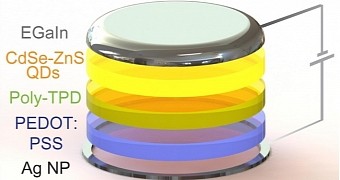Quantum dot light-emitting diodes are similar to normal LEDs from TVs and monitors, but they have much higher color purity and durability, as well as flexibility and efficiency.
You'd think that it would take some really complicated production processes to make them, and you'd be right. However, it's not a case of a totally new fabrication technique, but of one that the majority of the world's people know about by now. Well, the people who routinely tune in to the net.
Researchers from Princeton have managed to create a quantum dot LED entirely by means of 3D printing.
More precisely, they have created a custom 3D printer that was able to make a quantum dot LED from five layers, each a different material. It took three months and around twenty grand to create said printer.
The first layer is a conductive base shaped like a nanoparticle ring made of silver. Two polymer layers are stacked on it, after which come the actual quantum dots (consist of cadmium selenide nanoparticles which have been wrapped in a shell made of zinc sulfide), and finally, an eutentic gallium indium cathode that allows electrodes to leave the LED.
Currently, the LEDs are expensive, but additive manufacturing is basically synonymous with cost savings and speed, so you can be sure that they'll become affordable pretty soon.

 14 DAY TRIAL //
14 DAY TRIAL //